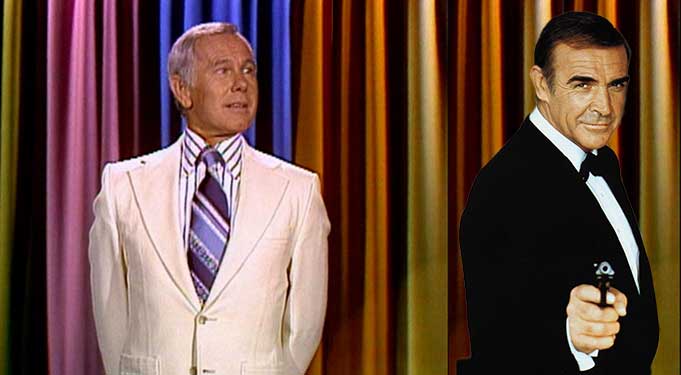 If you’re into pop culture anthropology, the first week of October 1962 offers a rich terrain for study. Within a period of five days, two notable events occurred.
If you’re into pop culture anthropology, the first week of October 1962 offers a rich terrain for study. Within a period of five days, two notable events occurred.
On Monday, Oct. 1, Johnny Carson took over hosting The Tonight Show, North America’s most popular late-night television slot. Four days later and across the Atlantic, the James Bond movie franchise debuted at the London Pavilion on Piccadilly Circus.
Carson was essentially a North American phenomenon, albeit one that enjoyed a 30-year run. Bond, on the other hand, soon went global in a big way.
Carson didn’t invent Tonight, nor was he the first host. The show made its NBC network debut in 1954 with Steve Allen at the helm. And even then, it was an adaptation of something Allen had previously presented for the New York television market.
 |
| Related Stories |
| Could Chapel Hart change the face of country music?
|
| Comedy is a powerful force in exposing what is wrong
|
| The past is a foreign country. Just ask Keith Richards |
But Carson made Tonight his own. Over the following three decades, the late-night talk genre became synonymous with him. Ably supported by sidekick Ed McMahon, he turned the show into an addictive end-of-day stop for millions.
The fare on offer ranged from comedy to music to conversation of all sorts. Sometimes the chat was light and frivolous; other times more serious. If you had a book, movie or record album to promote, Carson’s show was a very desirable platform.
The man you saw on the screen was smooth, sophisticated, suave and funny. Quick-witted, he had a sense of humour that could veer into the wicked. From time to time, he might even be biting.
But public personalities aren’t always what they seem. The projected persona can be at odds with the reality of the underlying person.
For instance, the late film actor Cary Grant came across as self-confident, witty and debonair – the epitome of what a mid-20th-century male might aspire to. In private life, he was “socially insecure and inclined to isolation.”
Something similar might be said of the off-camera Carson.
If you expected him to dazzle your social gathering with scintillating conversation, you’d be disappointed. He could be defensive, withdrawn and uncomfortable. No doubt partially tongue-in-cheek, he once described his penchant for privacy this way: “I will not even talk to myself without an appointment.”
Ian Fleming’s first James Bond novel appeared in 1953. But it was the sixth – Dr. No – that brought his creation to the screen. Published in 1958, the book had attracted some heavy-duty criticism. The New Statesman’s review was probably the most scathing.
Under the heading Sex, Snobbery and Sadism, Paul Johnson described it as “the nastiest book I have ever read.” It displayed, he said, “the sadism of a schoolboy bully, the mechanical two-dimensional sex-longings of a frustrated adolescent, and the crude, snob-cravings of a suburban adult.”
Despite these characteristics – or maybe because of them – the Bond novels developed a large audience. And according to a 1961 article in Life magazine, one of Bond’s devotees was none other than John F. Kennedy, the new American president. A prospective movie franchise was lurking.
But bringing Bond to the screen posed challenges. One was casting the leading role. Another was finding the finance.
Legend has it that many actors were considered, some famous and others less so. In the end, the Scotsman Sean Connery got the nod.
Tall, dark and handsome, Connery projected a highly virile presence. He’d been in the business for a while and had a number of film appearances under his belt but was some distance from genuine star status. Bond changed all that.
Interestingly, film studios didn’t rush to put up the requisite financing. It wasn’t bidding war time. Eventually, however, United Artists came up with the funds, and Dr. No went before the cameras in Jamaica in January 1962, with shooting completed in England by the end of March.
Following the Oct. 5 premiere, it was an immediate hit in the U.K., quickly becoming one of 1962’s highest grossers. U.S. reaction the following year was also positive, albeit not on the same scale. In fact, the Bond phenomenon didn’t truly ascend into the American box-office stratosphere until the third and fourth movies in the series – Goldfinger and Thunderball.
Leaving aside the parody version starring David Niven, there have been 26 Bond movies between 1962 and 2021. And of the six actors who’ve played the lead role, Connery remains the most memorable.
Sometimes an original can’t be equalled.
Troy Media columnist Pat Murphy casts a history buff’s eye at the goings-on in our world. Never cynical – well, perhaps a little bit.
For interview requests, click here.
The opinions expressed by our columnists and contributors are theirs alone and do not inherently or expressly reflect the views of our publication.
© Troy Media
Troy Media is an editorial content provider to media outlets and its own hosted community news outlets across Canada.


